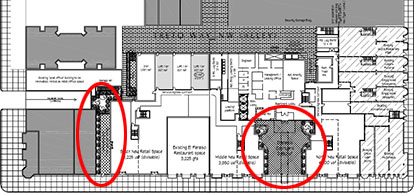Historic review chickens and BZA eggs at 14th and U
When a developer presents a plan to build in a historic district, they first go through the historic preservation process, where Historic Preservation Office (HPO) staff work with the developer to shape and, sometimes, cut back parts of the project to fit in with the historic district. Once that is approved, if the project requires any zoning variances, they present the project to the Board of Zoning Adjustment (BZA). Finally, if the project will use public space, DDOT rules on that.
The Hill Rag reports that northeast Capitol Hill’s ANC, 6A, thinks that process is backwards. “How can HPRB rule on design issues when BZA hasn’t ruled on how much space you can occupy and for what uses, and how can BZA decided how much space you can use without talking to Public Space?” asked Commissioner Nicholas Alberti. According to the article, other cities put zoning approval first.
Whichever way we do it, developers hit chicken-and-egg situations. At the “Utopia” project planned for 14th and U, HPO asked the developer to change several elements which created needs for zoning variances. The current rules require a 15-foot “rear yard” which has to span the entire width of the lot. But on a corner lot, there’s no “rear”, so one edge of the lot has to get the open space. Inevitably, it will therefore touch one of the sidewalks, creating a gap in the buildings.
Top: Early plans for 14th and U including “rear yard” (at left) and entrance
courtyard. Bottom: Current plans to be presented to BZA.
Both 14th and U are busy commercial streets, and we don’t want gaps in the streetwall on either block. On the U Street side, the lot has historic townhouses along the entire length, and obviously we shouldn’t tear one down. To comply with zoning rules, therefore, the original plans designated U Street as the “front” and had a “rear yard” that made a gap facing 14th. Rightfully, HPO asked the developer to remove this, but the BZA has to grant a variance to allow it.
Likewise, section 633 of the rules for the CR zone require 10% of the lot area to be open space around the building’s entrance. That’s a really bad zoning rule, because it creates gaps that also diminish the pedestrian usability of a street. We should discard this in the rewrite, but in the meantime, the BZA has to give variances for this as well. HPO rightfully asked the developer to remove the courtyard, which became a one-story entrance area, preserving the vertical open space above but maintaining a continuous streetwall.
Since HPO asked for changes which necessitate variances, it made sense for the developer to undertake historic review before approaching BZA with a list of variances. At the same time, the historic review doesn’t always consider all zoning factors. When Dupont Commissioner Bob Meehan read the zoning rules in preparation for the developer’s presentation on requested variances, he discovered loading dock rules he hadn’t been aware of. The community has already been through a year of discussion and debate, which reduced the size and bulk of the project and crafted an acceptable compromise; now is not the time to reexamine the plans. Some commissioners, however, felt it necessary as they read zoning rules for the first time.
The Dupont ANC ultimately voted to approve three variances: for having no front entrance courtyard, for allowing greater lot occupancy to provide more ground-floor coverage, and for the parking entrance to go on 14th Street instead of the alley.
They declined to approve the rear yard variance, however. Some Commissioners may have misunderstood the term “rear yard”, wondering why the green space behind part of the building doesn’t count. That fits the common sense understanding, but the official definition requires open space spanning the entire width of the lot. Some worried that by allowing no rear yard, the developer could later change course remove that rear green space. Others, such as Chairman Ramon Estrada, brought up a desire to further reduce the size of the overall project through this zoning requirement.
Commissioner Will Stephens, joined by Jack Jacobson and Bill Hewitt, proposed an amendment to approve the variance conditional on the currently-shown rear open space remaining part of the plan. Commissioners Estrada, Carney, Meehan, Silverstein and Wexler rejected the amendment and passed Estrada’s resolution not approving the variance.
Doug Rogers, challenging Estrada for the seat that includes this project, posted a scathing critique:
The developer has … patiently worked with the ANC in good faith. The developer has worked with neighbors and historic preservationists to alleviate their concerns about the architecture, height and density of the project. … However, my opponent continues to put obstacles in the way to block this project. I believe his ‘concerns’ are an effort to mask his personal opposition to the project.
Our society needs smart-growth initiatives like the Utopia project near major transportation hubs. And all the better if they can be pleasing architecturally and friendly to neighborhood concerns.
It’s time for this project to move forward. After a year of discussion, we have a good plan that replaces dumpy fast-food chains and a surface parking lot with needed residential density and street-level retail in a lively, transit-rich area. I plan to support the requested variances before the BZA.
Longer term, maybe we should examine some process changes that bring up zoning issues before the eleventh hour. In this case, it was good for HPO to also be involved from the start, but perhaps initial historic review and final historic approval could sandwich the BZA and DDOT part of the process. At the very least, we should help affected ANC commissioners fully understand the zoning issues, to avoid any last-minute zoning surprises.



